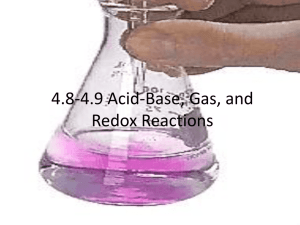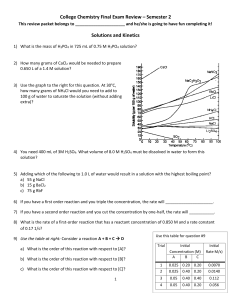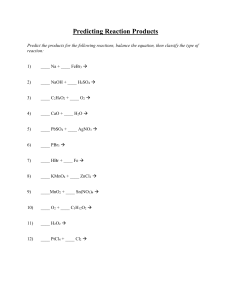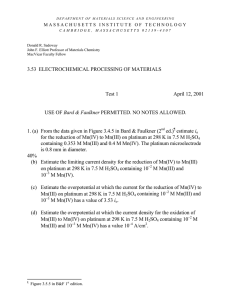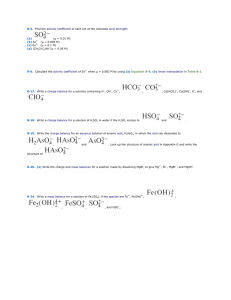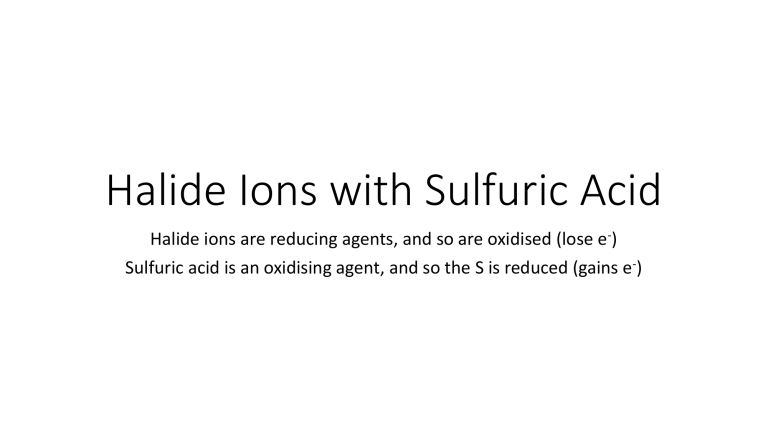
Halide Ions with Sulfuric Acid Halide ions are reducing agents, and so are oxidised (lose e-) Sulfuric acid is an oxidising agent, and so the S is reduced (gains e-) Reaction of NaF with H2SO4 • No redox reaction; it is a displacement reaction. • Overall equation: 2NaF (s) + H2SO4 (l) ==> Na2SO4 (s) + 2HF (g) OR NaF (s) + H2SO4 (l) ==> NaHSO4 (s) + HF (g) • Ionic equation: F- (s) + H+ (l) ==> HF (g) Reaction of NaCl with H2SO4 • No redox reaction; it is a displacement reaction. • Overall equation: 2NaCl (s) + H2SO4 (l) ==> Na2SO4 (s) + 2HCl (g) OR NaCl (s) + H2SO4 (l) ==> NaHSO4 (s) + HCl (g) • Ionic equation: Cl- (s) + H+ (l) ==> HCl (g) Reaction of NaBr with H2SO4 • Redox reaction in which the oxidation state of bromine changes from -1 in Br- to 0 in Br2 (oxidation, increase in oxidation state by 1). The oxidation state of sulfur changes from +6 in H2SO4 to +4 in SO2 (reduction, decrease in oxidation state by 2). • Overall equation: 2NaBr (s) + 2H2SO4 (l) ==> Na2SO4 (s) + Br2 (g) + SO2 (g) + 2H2O (l) OR 2NaB (s) + 3H2SO4 (l) ==> 2NaHSO4 (s) + Br2 (g) + SO2 (g) + 2H2O (l) Reaction of NaBr with H2SO4 • The overall reaction can be broken down into two equations (as found in CGP book): NaBr (s) + H2SO4 (l) ==> NaHSO4 (s) + HBr (g) 2HBr (g) + H2SO4 (l) ==> Br2 (g) + SO2 (g) + 2H2O (l) Reaction of NaBr with H2SO4 • Half-equations: 2Br- ==> Br2 + 2e- (oxidation, 2 e- lost) H2SO4 + 2H+ + 2e- ==> SO2 + 2H2O (reduction, 2e- gain) • Overall net ionic redox equation: 2Br- + H2SO4 + 2H+ ==> Br2 + SO2 + 2H2O Reaction of NaI with H2SO4 • Redox reaction in which the oxidation state of iodine changes from -1 in I- to 0 in I2 (oxidation, increase by 1 in oxidation state). The oxidation state of sulfur changes from +6 in H2SO4 to -2 in H2S (reduction, decrease in oxidation state by 8) • Overall equation: 8NaI (s) + 5H2SO4 (l) ==> 4Na2SO4 (s) + 4I2 (g/s) + H2S (g) + 4H2O (l) OR 8NaI (s) + 9H2SO4 (l) ==> 8NaHSO4 (s) + 4I2 (g/s) + H2S (g) + 4H2O (l) Reaction of NaI with H2SO4 • The overall reaction can be broken down into three equations (as found in CGP book): NaI (s) + H2SO4 (l) ==> NaHSO4 (s) + HI (g) 2HI (g) + H2SO4 (l) ==> I2 (g) + SO2 (g) + 2H2O (l) 6HI (g) + SO2 (g) ==> H2S (g) + 3I2 (s) + 2H2O (l) Reaction of NaI with H2SO4 • Half-equations: 2I- ==> I2 + 2e- (oxidation, 2 e- loss) H2SO4 + 2H+ + 2e- ==> SO2 + 2H2O (reduction, 2e- gain) H2SO4 + 8H+ + 8e– ==> H2S + 4H2O (reduction, 8 e- gained) • Overall net ionic redox equation: 8I– + H2SO4 + 8H+ ==> 4I2 + H2S + 4H2O Reaction of NaI with H2SO4 • Iodide is such a strong reducing agent that it can reduce the SO2 to H2S or S. • The half equation for S is: 2I- ==> I2 + 2e- (oxidation, 2 e- loss) H2SO4 + 6H+ + 6e- ==> S + 4H2O (reduction, 6 e- gain) • Overall net ionic redox equation for S: 6I- + H2SO4 + 6H+ ==> 3I2 + S + 4H2O
